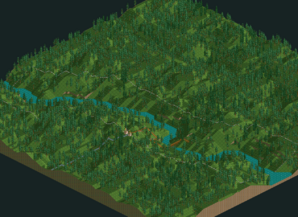Walkthrough[edit]
Rainbow Valley has a mess of cliffs and trees that make it difficult to construct new rides and pathways, but what makes this the most aggravating of the original scenarios is that the land must be left as it is. Not only are you not allowed to sculpt the terrain or tear down the trees, but if new trees or scenery are added, you're not allowed to tear down those as well! Furthermore, the entire park consists of one long strip of land with no way to buy more, making it even more awkward to build coasters. There is a lot of time to get to 1,000 guests, but it will require foresight, planning, and roller coasters.
It's best to start with building a Steel Mini Roller Coaster immediately to gauge where's a good spot to build. With the ability to place chains on turns and being able to use steep drops immediately, this type of coaster is flexible enough to use. Since the trees will make it difficult to build, you can use the cliffs that are scattered around the park. A good place to start is near the bridge as that has a ton of cliff space. Be absolutely sure that the cliff you're building into is two units high for the roller coaster to fit. More importantly, make sure that there's a way to get out of the underground. If you find yourself building a long, convoluted path just to get above ground, then it may be best rebuild the underground portion or find a different cliff. Since there's not a lot of underground space, it's imperative to use what little space you have wisely. Feel free to delete or edit the existing pathways if they get in the way. Your coaster should have a fun rating of at least 4 to be passable. If the test results of the completed ride are poor, restart from the beginning and try again.

When your coaster is done, hire your mechanics and handymen and set research to Roller Coasters to get the useful Steel Roller Coaster and Stand-Up Steel Roller Coaster. Don't forget to set it to Thrill Rides later to get the compact Go-Karts and Motion Simulator. When placing set rides like the Carousel, it's important to figure out where the entrance and exit will go as well as space for the ride itself. If placing the ride entails having a convoluted exit path, then it's best to find another place to put the ride. Building your rides too high can be difficult for queue lines and exit paths to go down to the main path so make sure there's enough space. As for shops and stalls, decide carefully on where you want them to go to keep them from blocking future rides. Thankfully you can tear the shop down if it turns out to be a nuisance.
Expanding will be tricky as the trees can sometimes create dead ends for rides and paths. With so much sloped terrain, you'll also be forced to build a lot of sloped paths. It's important to have some flat paths near the ground so you can build shops and stalls as you can't raise the ground so they can connect with the path. Use the water area for track-based rides only as it's vital to build a few coasters to win and there's little free space on land. Rides like the Log Flume and Single-Rail Roller Coaster should be avoided as they're simply not flexible enough to handle the forest. Rides with small turns like Go-Kart tracks, the Wooden Crazy Rodent Roller Coaster, and River Rapids will be very useful if the trees prove to be too much. You should be able to reach your goal with five to six coasters, ample advertising, and around a dozen smaller rides scattered around.
Available Items[edit]
Researchable Items[edit]
- Corkscrew for Stand-Up Steel Roller Coaster
- Half Loop for Stand-Up Steel Roller Coaster
- Vertical Loop for Steel Corkscrew Roller Coaster
- Half Loop for Steel Corkscrew Roller Coaster
